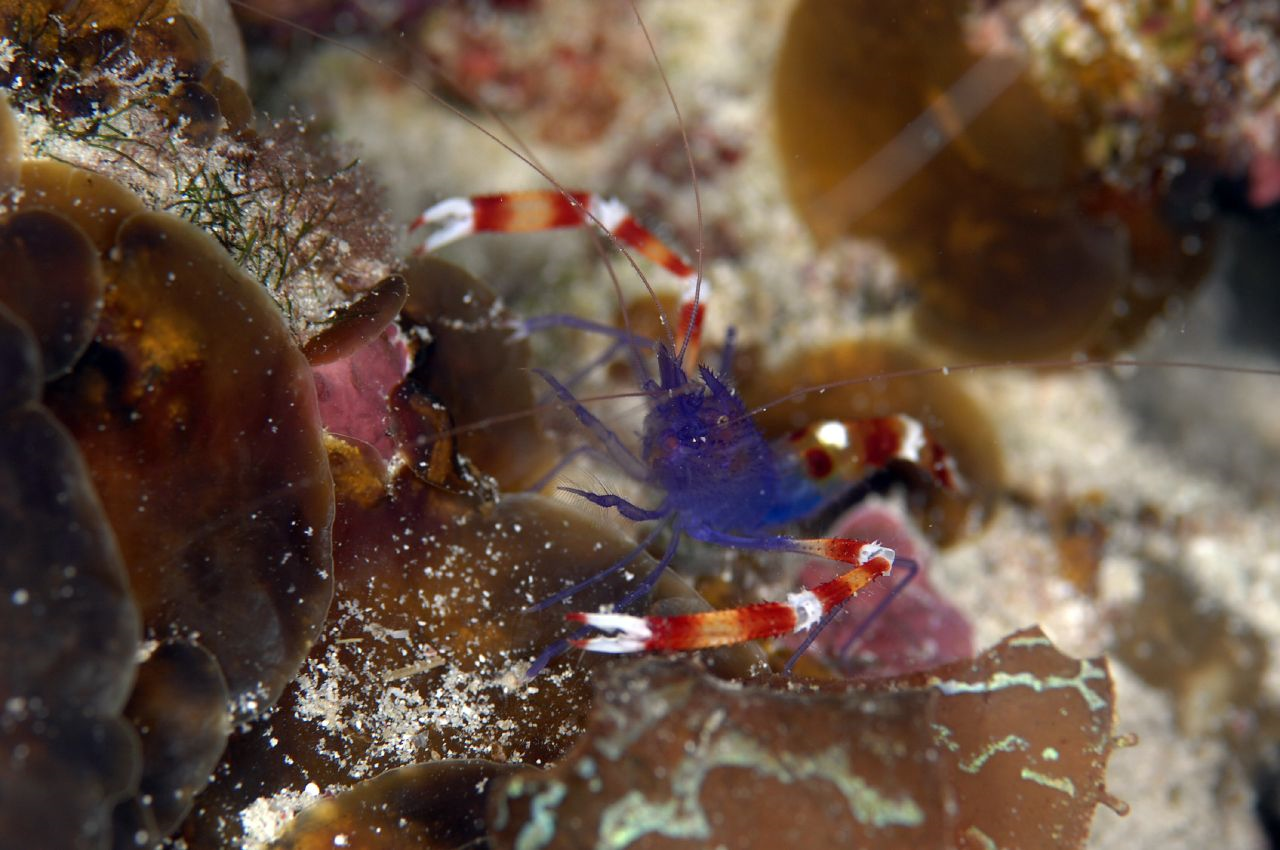The Coral Banded Shrimp (Stenopus hispidus) is a staple of the aquarium hobby, but there are many more species in its genus that are less familiar to aquarists. Nearly all of the dozen or so species appear in exports from time to time. Some are regularly encountered, and some are rare enough to be the crustacean equivalent of a Peppermint Angelfish. Part of the difficulty in identifying these shrimp is the lack of a single resource that covers the group in its entirety. So let’s remedy that, with a quick and painless guide to the identification of the Boxing Shrimp of the genus Stenopus. (image above: S. tenuirostris Credit: etepon)

Stenopus chrysexanthus
Range: Indo-West Pacific
Etymology: Greek, “golden-yellow”
Aquarium Rarity: Absent
Size: Small
ID: Rostrum red & abdomen yellow; three pairs of spots on the abdomen and a broad red band just before tail; tail yellow, with middle red and red stripes along the uropods, the posterior margin white; banding pattern on arms distinctive and as depicted in photo
Note: There are apparently no existing photographs of this species. The image included here is of scutellaris with the colors of chrysexanthus overlaid onto it as described in its original description—it will likely vary in minor details from the true form, but the general impression should be the same. Why this species is so poorly documented is unknown, as it has a wide range and occurs in relatively shallow waters. It may be particularly reclusive.

Stenopus cyanoscelis
Range: Indo-West Pacific
Etymology: Greek, “blue legs”
Aquarium Rarity: Uncommon
Size: Small
ID: Legs violet & carapace yellow; dark parallel stripes on 2nd+3rd abdominal segments, followed by red and white bands; antennae white


Stenopus devaneyi
Range: Indo-West Pacific
Etmology: after crustacean researcher Dr. D. M. Devaney
Aquarium Rarity: Rare
Size: Small
ID: Two large red spots near base of abdomen; carapace+abdomen varies from yellow to white; red bands variably present on arms and abdomen; legs+antennae white


Stenopus earlei
Range: Indo-West Pacific
Etymology: after famed marine biologist Dr. Sylvia Earle
Aquarium Rarity: Rare
Size: Small
ID: Paired red lines running along abdomen; carapace dotted with red; arms red; legs red in first segment, white beyond the “knee”


Stenopus goyi
Range: Indo-West Pacific
Etymology: after Dr. Joseph W. Goy, noted authority on Stenopus
Aquarium Rarity: Rare
Size: Small
ID: Rostrum red & abdomen white; last two pairs of legs with thin red band near “knee”; tail with medial red band; a pair of red lines on carapace


Stenopus hispidus
Range: Circumtropical
Etymology: Latin, “bearing coarse stiff hairs”
Aquarium Rarity: Common
Size: Medium
ID: Bases of legs violet; carapace+abdomen+tail and arms white, with red bands


Stenopus pyronotus
Range: Indo-West Pacific
Etymology: Greek, “fire-backed”
Aquarium Rarity: Uncommon
Size: Large
ID: A single red stripe running along top of abdomen; body otherwise white

Stenopus scutellatus
Range: Western Atlantic & Gulf of Mexico
Etymology: Latin, “little shield”
Aquarium Rarity: Uncommon
Size: Small
ID: Rostrum+carapace+abdomen yellow; legs yellow; antennae white; arms red & white; abdomen with two pairs of red spots in rear half, small unpaired white spots between these; tail with red medial band


Stenopus spinosus
Range: Mediterranean & Gulf of Mexico
Etymology: Latin, “spiny”
Aquarium Rarity: Absent
Size: Large
ID: Solid orange carapace+abdomen+legs; antennae white; tail with red spots on each side of a faint central white spot


Stenopus tenuirostris
Range: Indo-West Pacific
Etymology: Latin, “thin beak”
Aquarium Rarity: Uncommon
Size: Small
ID: Purple carapace and legs; arms and abdomen banded in white red and yellow; antennae a clear red
Note: This species shows an unusual prevalence for residing near mantis shrimp, moray eels, and tube anemones.


Stenopus zanzibaricus
Range: Indo-West Pacific
Etymology: Latin, “from Zanzibar(Kenya)”
Aquarium Rarity: Rare
Size: Small
ID: Antennae red & tail white; abdomen white, with two red bands; arms with a single prominent red band on first segment, and a faint orange band on each of the last two segments; legs white on first segment, red beyond the “knees”


Stenopus cf zanzibaricus
Range: unknown
Aquarium Rarity: Rare
Size: Small
ID: Antennae red & tail with red band; abdomen yellow; abdomen near bae with small paired dark-red spots, followed by a white spot and a red band; arms with a strong red band in each segment; legs white on first segment, red beyond the “knees”
Note: It is uncertain if this is a variant of the true zanzibaricus, but the many differences in coloration suggest it deserves species status. The true zanzibaricus is described from the Indian Ocean, and it may well be shown that this form originates in the Pacific as its allopatric sister.



